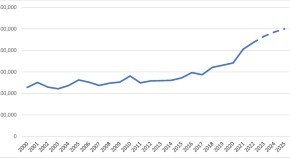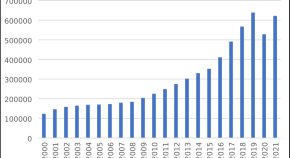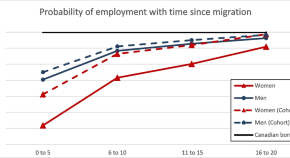
Collection
Canadian immigration policy: Opportunities and challenges for the road ahead
- Submission status
- Closed
The COVID-19 pandemic has led to a record drop in migration flows in most OECD countries (OECD 2021). While countries such as Australia and New Zealand have lowered immigration targets, Canada has taken a different approach - increasing targets from 351,000 to 401,000 permanent residents in 2021. The numbers are set to increase again to 411,000 in 2022 and 421,000 in 2023. Canada’s response to the COVID-19 crisis underscores its distinctive approach to immigration policy. Since the early 1990s, the Canadian government has maintained a stable, or growing, number of permanent resident admissions, regardless of economic conditions (Trebilcock 2019). Moreover, public attitudes towards immigration have remained remarkably positive, likely because the focus has been on selecting economic immigrants, mostly skilled workers, for their ability to contribute to the labour market (Environics 2021). It is important to acknowledge, however, that there are some conspicuous cracks in the system. Canada now welcomes significantly more temporary residents (international students and temporary foreign workers of various skill levels) per year than permanent residents. The expansion of temporary migration may foster exploitative working conditions, lowering labour standards for all workers and reducing migrants to disposable labour (Walsh, 2014). Another significant source of concern has been the growing labour market disparity between new immigrants (particularly those from non-European backgrounds) and native-born counterparts (Hou 2013). Considering the unprecedented global circumstances, the successes and limitations of the Canadian immigration model may offer insights for other immigrant-receiving countries.
The proposed special issue critically reflects on Canada’s immigration system to understand the opportunities and challenges that lie ahead. The aim is to gather lessons which will be useful to migration scholars and policy makers throughout the world. The special issue examines Canada’s approach to immigration targets and selection, the relationship between temporary and permanent migration, and the effectiveness of the Canadian system for various groups of immigrants and Canada as a society. Although migration research is inherently interdisciplinary, it is often fragmented and siloed by subject area. Scholars rarely engage in open dialogue with colleagues who approach the topic from different normative, theoretical, or empirical perspectives. Therefore, this special issue makes a deliberate effort to explore the Canadian immigration model through a variety of disciplinary lenses and methodological approaches.
Editors
-
Rupa Banerjee
Rupa Banerjee is Canada Research Chair in Economic inclusion, Employment and Entrepreneurship of Canada’s Immigrants and Associate Professor of Human Resource Management and Organizational Behaviour at the Ted Rogers School of Management, Ryerson University. Her primary research interest lies in the employment integration of new immigrants to Canada. She is particularly interested in the institutional barriers facing new immigrants in the Canadian labour market. Next to this journal, Dr. Banerjee’s research has appeared in such journals as "International Migration Review, Ethnic and Racial Studies", "International Migration".
Articles (7 in this collection)
-

-
The Education-Immigration Nexus: Situating Canadian Higher Education as Institutions of Immigrant Recruitment
Authors
- Sandra Schinnerl
- Antje Ellermann
- Content type: OriginalPaper
- Published: 27 May 2023
- Pages: 599 - 620

-
Opportunities and Cracks in Canada’s Two-Step Migration Model During the Pandemic: Lessons from Chinese Migrant Experiences
Authors
- Amrita Hari
- Chen Wang-Dufil
- Content type: OriginalPaper
- Published: 24 March 2023
- Pages: 641 - 659
-
The Role of Employers in Selecting Highly Skilled Immigrants: Potentials and Limitations
Authors
- Jeffrey G. Reitz
- Content type: OriginalPaper
- Published: 22 March 2023
- Pages: 621 - 639
-
The Effect of Pre-immigration Canadian Work Experience on the Returns to Human Capital Among Immigrants
Authors
- Garnett Picot
- Feng Hou
- Content type: OriginalPaper
- Published: 20 March 2023
- Pages: 661 - 679

-
The Work Trajectories of Married Canadian Immigrant Women, 2006–2019
Authors
- Ana Ferrer
- Yazhuo (Annie) Pan
- Tammy Schirle
- Content type: OriginalPaper
- Published: 25 February 2023
- Pages: 697 - 716

-
Policies, Potentials, and Pitfalls: the Impact of Economic Admission Categories on Recent Immigrant Earnings Disparities
Authors
- Danielle Lamb
- Rupa Banerjee
- Content type: OriginalPaper
- Published: 10 September 2022
- Pages: 681 - 696


